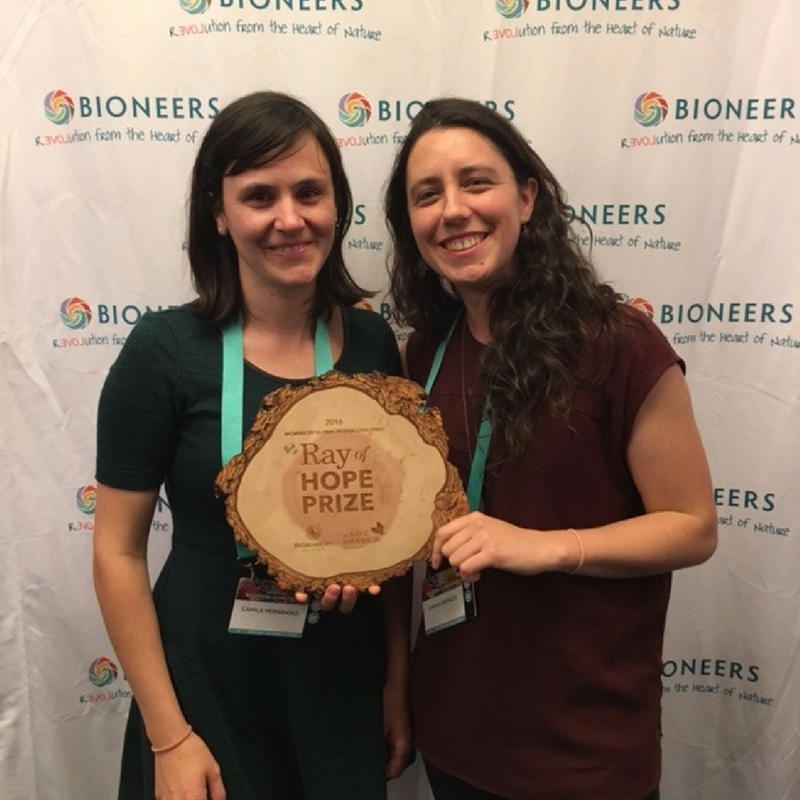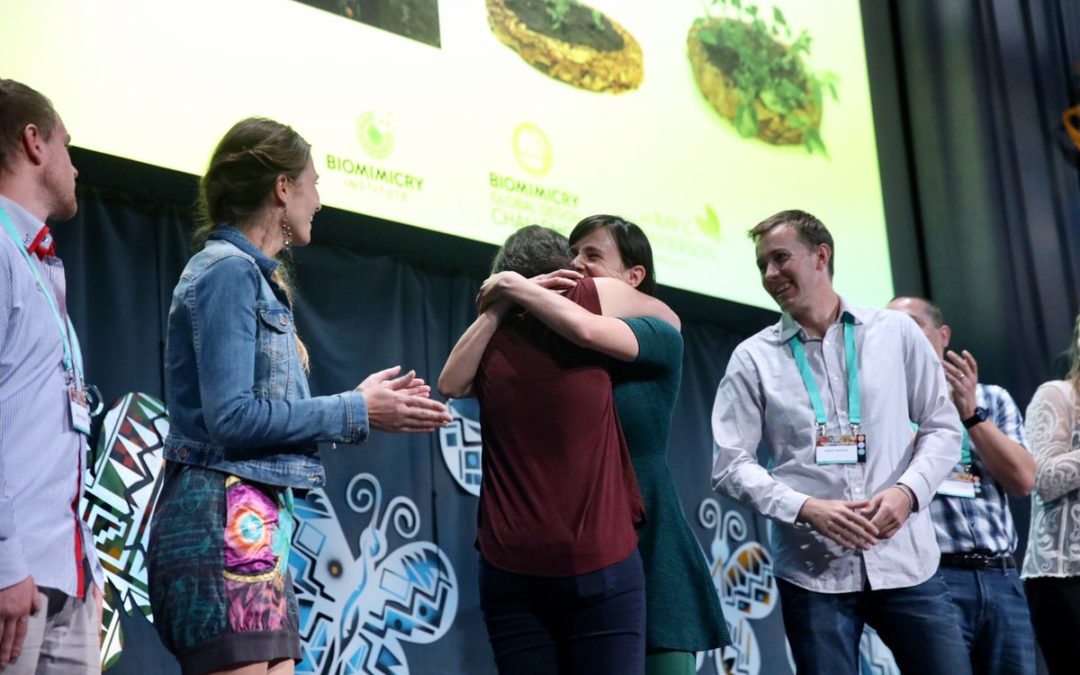Photo courtesy of Hardy Wilson, Bioneers
For a second, just before their lives changed with one announcement, the BioNurse team collectively held their breaths. When John Lanier, executive director of the Ray C. Anderson Foundation, the sponsor of the grand prize in the Biomimicry Global Design Challenge, announced that they won the $100,000 Ray of Hope Prize, they exhaled and hugged each other on stage, while the 1500-strong crowd gathered for the 2016 National Bioneers Conference erupted in applause.
“This was a big surprise for us,” said Camila Gratacos, one of the BioNurse team members. “After a lot of hard work, we just want to say thank you.”

Camila Hernandez (left) and Camila Gratacos (right) of Team BioNurse.
Seven teams entered the Biomimicry Global Design Challenge Accelerator program last October with a goal of bringing their biomimetic food system solution to market. They spent the past year meeting with mentors, testing their designs, and building prototypes, working to bring their design concepts to reality. Many juggled full-time jobs, school, and family while spending their nights and weekends honing their design because they knew that their solution could help change our food system for the better.
Last Saturday, the BioNurse team from the Ceres Regional Center for Fruit and Vegetable Innovation in Chile won the first-ever Ray C. Anderson Foundation Ray of Hope Prize, a $100,000 award that will allow them to propel their design to heights they could have barely imagined a year ago.

Here are five reasons why the Team BioNurse’s BioPatch design is going to change things for the better:
- The BioPatch helps create healthy soil. By exposing seedlings to a mix of nutrients, this design enhances the soil’s capacity to retain water, nutrients, and microorganisms.
- The BioPatch was inspired by nature. The team’s design mimics the way hardy “nurse” plants like the yareta (a type of cushion plant) establish themselves in degraded soils and pave the way for new plant species to grow.
- The BioPatch is waste-free. By using corn stalks as the material for the design, the team not only made the BioPatch biodegradable, but since corn stalks are often burned after harvest, they incorporated a typical waste product into a useful design.
- The BioPatch is self-sustaining. After one year, the plants growing within it will be capable of reproducing the same conditions in a natural way.
- The BioPatch is low cost. Farmers don’t have to uproot crops to treat the soil and and they only need to use the BioPatch for one season. With over 25% of the world’s soil degraded, BioPatch offers an affordable, accessible way for farmers to restore soil back to health.
All seven Accelerator teams earned high praise from the Ray of Hope Prize judges. They complimented the Oasis Aquaponic System’s potential for impact in the developing world, the Jube’s brilliant combination of function and beauty, the BIOcultivator’s elegant design, the Mangrove Still’s innovative business model, the Living Filtration System’s clever agricultural transition strategy, and Hexagro’s successful integration of a physical technology with a broader social network strategy.

In fact, because of the high quality of all of the teams’ designs, as an added bonus to this year’s program, the trustees of the Ray C. Anderson Foundation awarded $20,000 to the Oasis Aquaponic System, $15,000 to the Jube team, and $10,000 each to the four other finalist teams, for a grand total of $175,000 in award money.
We here at the Biomimicry Institute and the Ray C. Anderson Foundation offer our sincere congratulations to the BioNurse team and all of the teams who competed for this first-ever $100,000 Ray of Hope Prize and can’t wait to see these prototypes make their way to market soon.
A brand-new round of the Biomimicry Global Design Challenge has just begun, which asks students and professionals around the world to develop biomimetic solutions to climate change. Could you be the next Ray of Hope Prize winner? There’s only one way to find out – learn more about the Challenge here.

